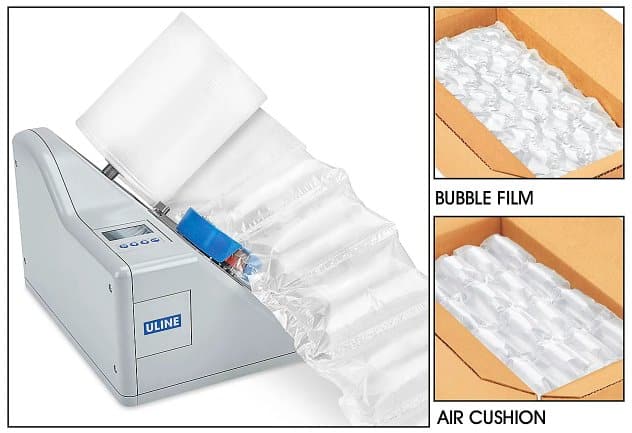Returns management is a supply chain process that addresses unwanted, recently purchased merchandise. It begins with a customer requesting to return an item and ends with the item being returned to inventory, refurbished, recycled, or otherwise disposed of.
This article guides you through the process of handling returns, returns management strategies to implement in your retail or ecommerce business, and tips on how to minimize returns.
How Returns Management Works
Returns management is a small part of the reverse logistics which encompasses all events and activities involved in sending a product, part, or material backward in the supply chain. It includes returns, recalls, repairs, refurbishment, repackaging for restock or resale, recycling, and disposal, and it’s primarily aimed at recapturing value or minimizing loss.
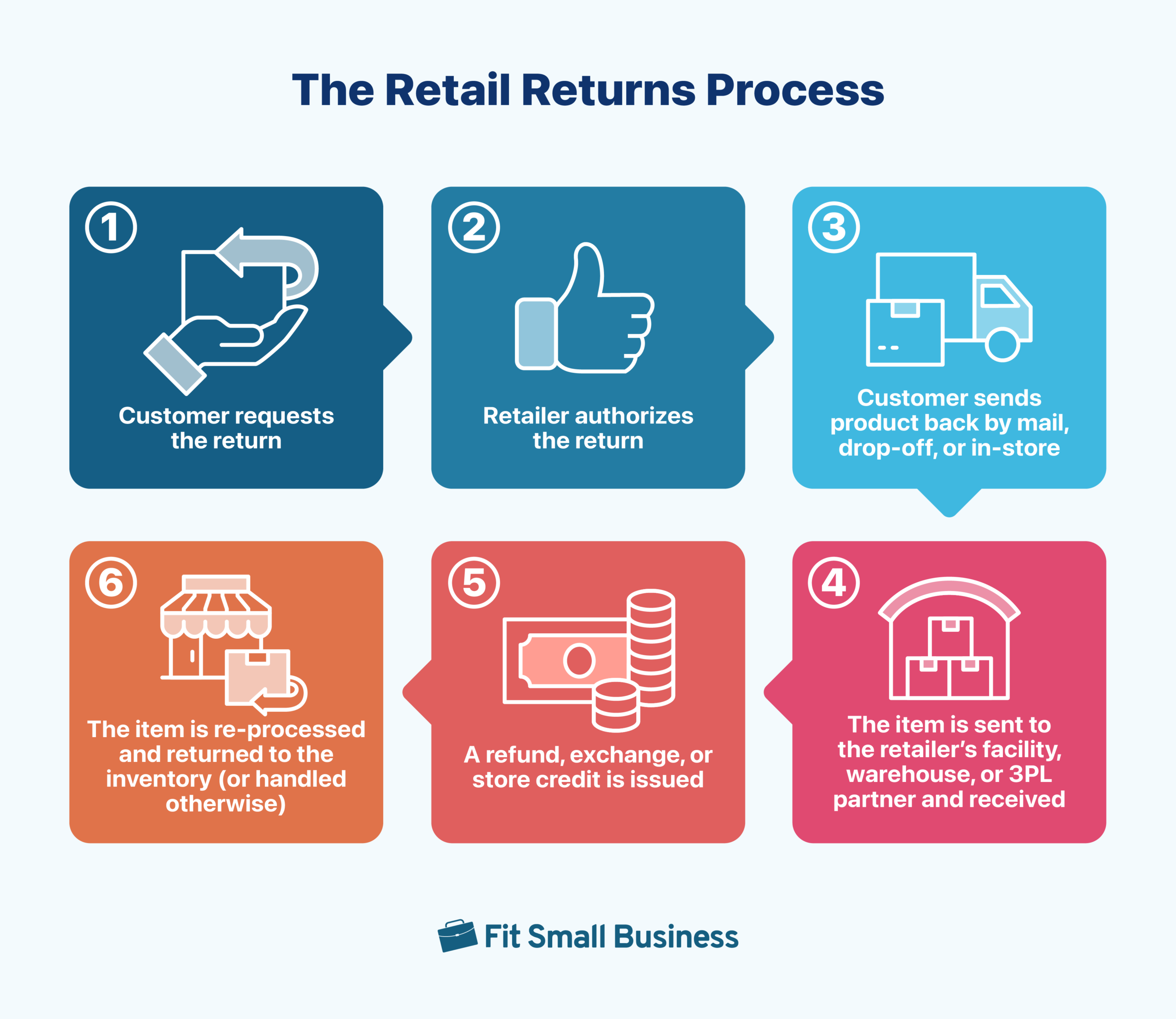
We can divide the backward cycle into three phases:
- Asset recovery: Collecting of goods from the consumer
- Reverse operations: Transporting the collected goods to the merchant’s reverse distribution center (if applicable), evaluating the product, repairing, repackaging, and preparing the product for shipping—recording and tracking every step of the process.
- Value generation: Determining if the returned item can be resold as new or used, or whether it needs to be returned to the manufacturer, donated, sold for parts, recycled, or properly disposed of.
State and federal regulations specify how returns must be handled. View the consumer return and refund laws for your state.
Reasons for Retail Returns
According to a 2022 consumer survey, the majority (45%) returned items of the wrong size, fit, or color. Nearly a quarter (16%) returned because of receiving damaged items, while 14% of consumers returned a product because it didn’t match the original description.
Aside from these reasons, there will always be a number of customers who buy with the intent of “return abuse.” This includes the practice of wardrobing (buying multiple variations of a product with the intention of returning some of them)—which the data shows is done by 63% of consumers.
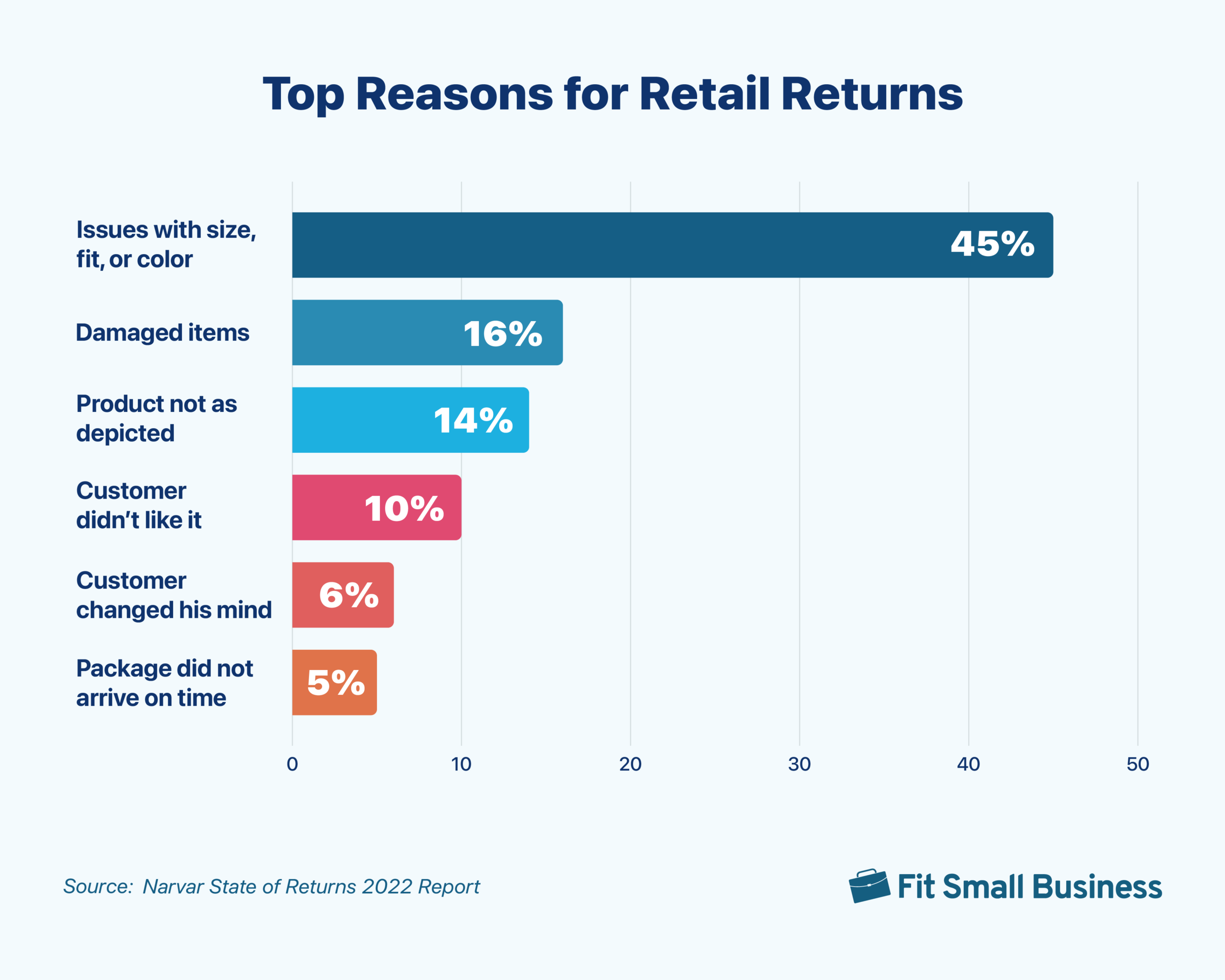
Returns Management Strategies
Retail and ecommerce returns are inevitable. In fact, the total rate of returns was 14.5% in 2023 according to the National Retail Federation. And for every $1 billion in sales, retailers lose $145 million in merchandise returns.
Handling returns is an important part of any retailer’s operating expenses. Here are some retail and ecommerce returns management strategies you can implement:
1. Determine How and Where to Accept Returns
Convenience is the primary factor in selecting a return method for 65% of consumers, so make it easy for your customers to make returns since it builds trust and impacts customer loyalty. Here are ways to accept returns from customers:
Offer Mail-in Returns
Mail-in returns can be handled in a few different ways. Maybe you include a pre-printed return label, complete with paid postage, and all customers have to do is package it up and schedule a pickup. In some cases, this won’t be possible. They can also bring the return to a post office or mail carrier near them, the preferred method for 31% of online shoppers.
Home Pickups
Thirty percent of consumers regardless of location are willing (probably or definitely) to use home pickup if it’s made available for the same price as other return methods. Otherwise, it goes down to as low as 6% if it comes with a fee.
Reading between the lines, fee-based home pickups should only be offered by brands with a customer base that’s either high-income or too busy to deal with returns themselves.
Open Third-party Drop Off Locations
You might also consider giving customers options for in-person returns dropoff. BORIS (buy online, return in-store) could work especially well if you have a brick-and-mortar store or a customer-friendly warehouse.
Even if you don’t have a physical presence, you can take advantage of retail stores through a third-party drop-off network. This involves dropping the return off at a store like Walgreens or the UPS Store, which then handles shipping the package to you.
Don’t worry about the proximity of locations too—69% of consumers are willing to travel over three miles to return an online order to a physical location such as a UPS Store or Kohl’s. What is important is meeting consumers within the context of their day-to-day lives—giving them options that fit into their existing routines (e.g., driving to work).
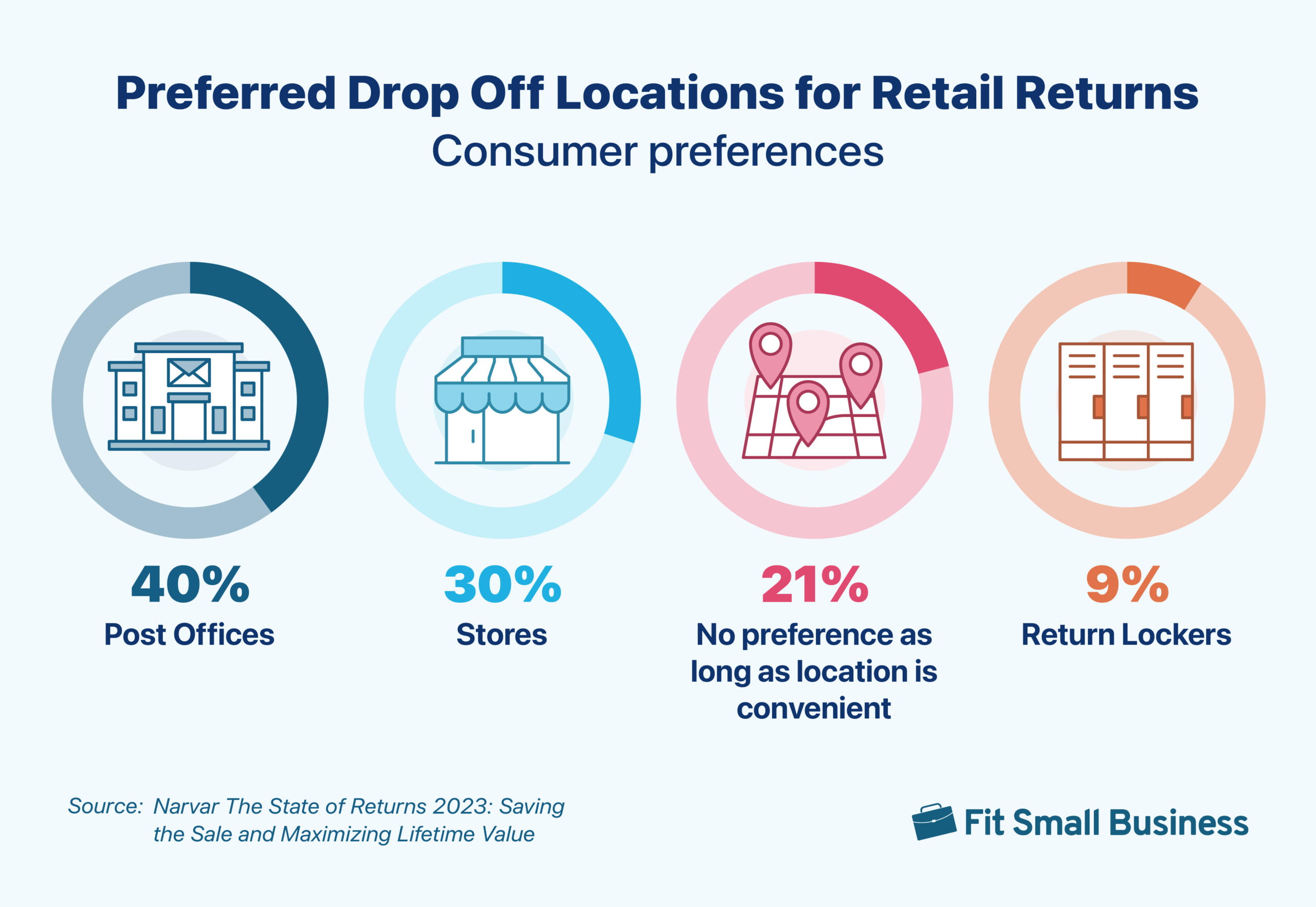
2. Establish Clear Receiving Procedures
How you manage your returns once they’re received will depend on what you do with them. Usually, returned goods can either be resold on your primary channel or dispositioned (which means sold elsewhere or discarded).
Depending on the category and condition of the item, you can choose to resell it in your store. In this case, create a procedure and location for returned goods to be quarantined, sanitized, and/or inspected—then restocked into inventory. If it isn’t in mint condition, consider listing the item at a discount or selling it to a separate liquidator.
Designate another location for defective goods to be stored. You can usually receive a refund or chargeback from the supplier in these cases, but it’s important to keep the merchandise on hand to be returned or documented.
If returned products cannot be resold (or have their value partially reclaimed through other means), designate a place to store goods for donation, recycling, or disposal.
3. Write a Clear Return Policy
Your return policy could be what separates you from the competition—or what causes potential customers to look for a similar product elsewhere. According to the Narvar State of Returns 2023 report, 42% of shoppers read a return policy before buying.
Customers aren’t likely to trust a retailer with their purchase unless they have a clear, agreeable return policy. Their desire to read your return policy before purchasing means you need to make the return policy easier to find and review to reduce the time to purchase.

An example of a clear, informative return policy. (Source: Austin Bazaar)
It’s vital to make your policy accessible and easy to understand. Here are some tips for creating your own:
- Write your return policy to thoroughly cover the details of how the transaction works. Generally speaking, requiring a receipt will combat fraud. Yet a decreasing number of retailers require receipts for returns, 71% for in-store returns and 85% for mail-in for 2022.
- Write your return policies in clear, simple language appropriate for your customer base. Prioritize clarity. Avoid intimidating legal jargon like “you are required to” or “we are not responsible for.” Instead, opt for friendlier ways to explain the process.
- Make it easy to find.
If you’re an ecommerce seller: Make sure the link to your return policy is accessible and easily visible from every page of your site. It also helps to use bullet points or infographics to convey the core details of your policy quickly.
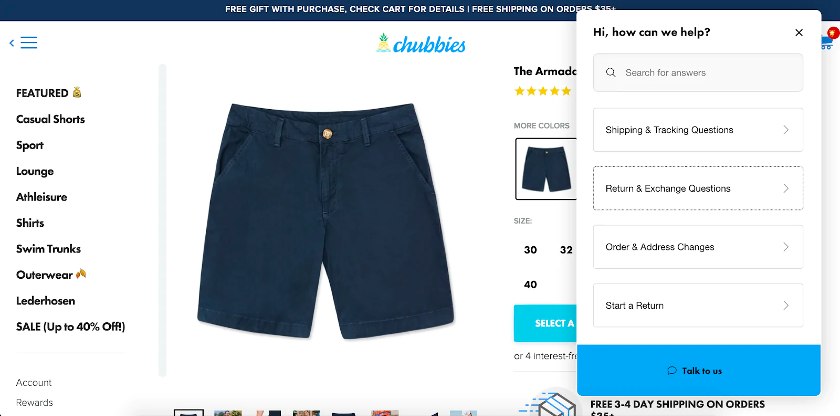
Take, for example, the retail clothing brand Chubbies. It includes return and exchange questions in its website chat window. You can also initiate a return with just one click.
If you’re a brick-and-mortar retailer: Display a physical copy of your policy near the checkout, the front door, or both. Also, include the policy in your receipt. Ensure your staff has the details memorized (including seasonal changes) or easily accessible and can quickly answer any related questions.
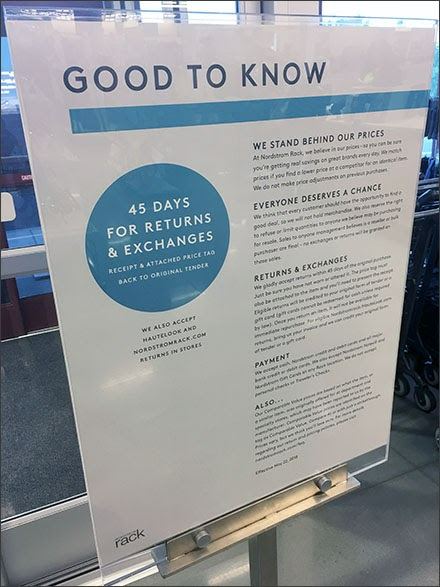
The return policy at Nordstrom Rack is brightly designed and displayed in-store. (Source: Fixtures Close Up)
4. Provide Returns Visibility
As with a clear and visible return policy, consumers expect and demand visibility into their returns the same way they wanted it during the last-mile delivery (of their purchase). Always update them on the status of their return, refund, or store credit.
Visibility in the return process, or over communication, builds trust and greater loyalty to your brand—just take a look at the numbers below from Narvar’s State of Returns 2023 report:
- 48% want a confirmation notification when an order is received
- 57% want a notification when their order is delayed
- 70% want a notification when their order is out for delivery
- 72% want a notification when their order is delivered
- 45% want a confirmation notification when their return is submitted
- 46% want a notification when their return is received by the merchant
- 58% want a notification when their return is accepted by the merchant
- 68% want a notification when their refund is issued by the merchant
An overwhelming majority of consumers obviously are not bothered by multiple notifications about their order deliveries and returns, so it’s beneficial to over-communicate with them.
5. Use Technology and Systems to Optimize Your Returns Management Workflow
An efficient returns management process reduces the time between a customer initiating a return and receiving a refund or replacement product. This all starts with a streamlined workflow for handling returns.
In the backend, there are some tools and processes you can implement to optimize the returns process:
- Return Merchandise Authorization (RMA): An RMA is a numbered authorization provided by ecommerce or mail-order businesses to allow a product return. These numbers make identifying incoming returns easy.
- Barcode/RFID readers, or handheld, wireless scanners: These tools scan and track returns faster. Wearable technology, in particular, such as scanners that attach to a glove or straps to a wrist, improves productivity and efficiency.
- Warehouse Management System (WMS): A WMS provides returns data to help process and improve the returns management workflow. Don’t forget to designate an area in the warehouse for returns when planning your warehouse layout.
- Standard operation procedure (SOP) manuals: These document your workflow in detail in printed form. These include all procedures and policies to determine the disposition category (restock, repair, recycle, repackage, return) and communicate it to the team handling returns.
Selling in-store? Have a POS System
Brick-and-mortar returns need to be even more efficient than ecommerce returns, thanks to the added urgency of a customer expecting quick, in-person service. For these operations, it’s vital to have a POS (point of sale) system capable of managing returns and processing refunds.
Read our guide to the best POS systems for small businesses to learn more.
6. Automate Your Returns Management Process
Automating your returns management workflow increases the efficiency of routing and processing requests and reduces costs and inaccuracies. Return management systems are web- or cloud-based platforms that help sellers handle returns smoothly.
You can use these tools to create a customer online portal for initiating returns and approval based on automated conditions—cutting down drastically on human labor and room for error. They can also facilitate exchanges, issue credit and tracking numbers, and automatically create and email return labels.
7. Outsource to a Fulfillment Company
Incorporating your returns (reverse logistics) into your fulfillment (outbound logistics) will significantly improve your returns management process. Moreover, partnering with a fulfillment company means outsourcing many labor-intensive processes—including fulfillment, inventory, and returns management.
If you implement this strategy, processing returns could be as simple as establishing your return policy and disposition preferences with the fulfillment center beforehand, and then having all returned merchandise sent to the company’s warehouse.
Not all 3PL fulfillment centers offer return services, but those usually have platforms allowing them to update you on your returned merchandise available for re-listing. ShipBob delivers the best return services, plus fast two-day shipping with no monthly minimum to get started. Contact ShipBob for a free quote.
8. Gather & Evaluate Your Current Returns Data
Track your returns data to identify which of your products have the highest return rate and investigate why.
Periodically tally the volume of returned products. Monitor not only the volume but also the percentage of items being returned. As a benchmark, average online return rates fell from 16.5% in 2022 to 14.5% in 2023.
Evaluating returns data also gives you insights into your returns management workflow and helps you understand the following:
- Each product and product category’s return rate
- Percentage of returns resold at full price, at a discount, or salvaged
- How to optimize your returns routing for efficiency
- The cost to process returns per product through each return channel
Read our related resources:
- Ecommerce Return Rates: Expert Guide for Small Businesses
- Retail Metrics: How to Drive Sales in Your Small Business
- Ecommerce KPIs to Track for Growth
How to Minimize Returns
The easiest way to handle returns is by preventing them in the first place. There are uncontrollable and controllable returns.
Uncontrollable returns are those returns merchants cannot control or prevent. This includes customers changing their minds or no longer needing the product.
Controllable returns are those that merchants can prevent and are the top reasons for product returns like issues with size and fit, products arriving damaged, and the item not meeting shoppers’ expectations.
Controllable returns result from inaccurate product representations, insecure packaging materials, manufacturing issues, and general mismanagement. Conflicts like customers finding a similar product for a better price elsewhere are also considered controllable, as product quality and price point are also within your control. Retailers can avoid these types of returns through better operations.
Here are some strategies to prevent controllable returns:
1. Increase Accuracy & Quality Control
A report noted that 45% of ecommerce returns are due to the consumer receiving the wrong size, fit, color, or even the correct item. Picking errors are a highly controllable factor in minimizing returns.
- Refine your order fulfillment process and quality control. Try modifying your shipping workflow to include an order-checking stage. This step is most effective when performed in a dedicated workspace by employees other than the pickers and packers.
- Establish clear standard operating procedures (commonly called SOPs) to create an error-free operation. Read our guide to ecommerce shipping and handling to download free SOP checklists or make your own.
- Shipping software and inventory management platforms can streamline order data and automate repetitive tasks—reducing the risk of human error.
Ultimately, the most effective way to perfect your fulfillment process is to outsource it to specialists like ShipBob. In our breakdown of in-house vs outsourced fulfillment, we found that hiring a fulfillment center is often more cost-effective for small retail businesses. Plus, ShipBob boasts a 0.02% error rate, meaning only 2 in every 10,000 orders have an issue. Visit ShipBob for a free quote.
2. Use Protective Packaging
Another one of the top reasons for ecommerce returns is damaged merchandise. While you have little to no control over how your parcels are handled, you can prevent damaged orders by using protective packaging.
- Use quality dunnage (such as air cushions or honeycomb sleeves) during the packing process. Crinkle paper is an elegant option that can create a fun unboxing experience—but make sure to use enough to cushion the product.
- Use waterproof lining or water-resistant poly mailers for merchandise susceptible to water damage.
3. Describe Your Product Listings Well
Take some time to ensure every listing on your ecommerce site sufficiently (and accurately) represents the product. The top reasons for online returns are fit, size, and color issues—“size and fit” taking the cake, making up 45% of returns in 2022, a jump from 42% in 2021 and 38% in 2020. This could be a sign that businesses are “still missing the mark despite extensive investments in size-fit technology.”
- Write effective product descriptions that are informative, clear, and persuasive. Ensure to include hard facts about materials, size, dimensions, usage, and other specs.
- Check if your product photos provide customers with as much info as possible. Aim to have 4 to 12 shots in every item’s gallery, including various photo types to answer any questions a viewer might have. Read our product photography guide to learn more.
- Consider adding product videos to your listings. Reports show that 69% of customers prefer to get information from a short video rather than photos or text.
Take a look at the example below:
For apparel, including sizing and conversion charts give viewers a solid understanding of how the item will fit. Consider building a useful UX tool like the ASOS Fit Assistant, which recommends a size based on user input and data from similar shoppers’ unreturned purchases.
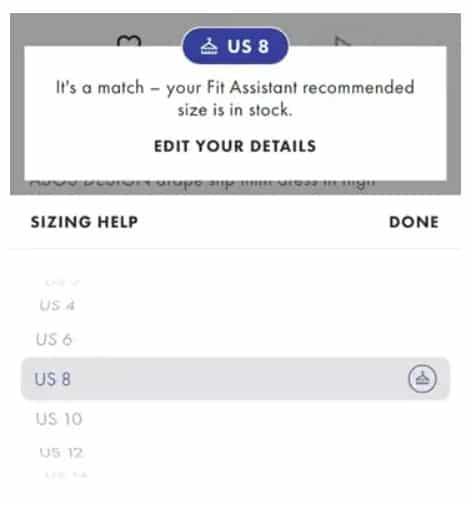
The ASOS Fit Assistant tool helps minimize returns by recommending accurate size selections. (Source: ASOS)
4. Encourage Customer Feedback
Input from your buyers is an invaluable tool to identify pain points and reduce returns. So, request their reason for returning the product.
On the initial return form or during communication, provide shoppers with an option to let you know why they are returning the item. However, some customers are prone to feeling scrutinized for making returns—if they feel like they need to pass a test for their return to be accepted, they’ll provide an inaccurate response.
The best data comes from giving customers a variety of valid return reasons. If your return policy aligns, include options such as “Incorrect size,” “Item arrived damaged,” “Simply changed my mind,” and “Found a better price elsewhere.”
Analyze the patterns in your incoming returns, and make adjustments accordingly.
Benefits of an Optimized Returns Process
Streamlining your returns process will give you benefits such as cost savings, improved sustainability, and ultimately, happier customers.
- Faster turnaround: An optimized returns process ultimately helps your business repair, refurbish, or reuse returned products.
- Reduced waste and improved sustainability: A streamlined returns management process lets you reuse, resell, or recycle materials that would otherwise end up in a landfill.
- Better profit margins: Optimizing returns ultimately cuts costs in several aspects, from reducing transportation spending to absorbing returned items for reselling.
- Increased customer satisfaction: Instant refunds, convenient drop-off locations, return tracking, and boxless/printerless returns are positive experiences that help them return for another purchase.
- Fraud prevention: There were 13.7% fraudulent returns in 2023, with holiday fraud returns increasing from 10.1% in 2022 to 16.5% in 2023. An optimized returns process includes a well-defined return policy that helps prevent fraudulent returns.
Related:What Is Return Fraud? A Small Business Guide
Returns Management Frequently Asked Questions (FAQs)
- Faster turnaround
- Reduced waste and improved sustainability
- Better profit margins
- Increased customer satisfaction
Returns management is also called reverse logistics, ecommerce returns management, or retail returns management.
Returns in supply chain management refers to the reverse logistics process of sending a product from the customer back to the seller. The seller may also even take the step to return products to suppliers if they feel inclined.
Bottom Line
Returns are an inevitable part of operating a retail business—whether you sell online, in-store, or both. Do not consider returns an operating cost but an integral part of your retail strategy.
Implementing sound strategies for your returns process can improve profit margins and, more importantly, customer experience and overall satisfaction.

